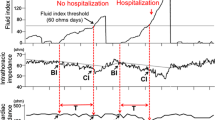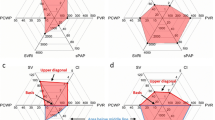Abstract
Purpose
Pulmonary edema (PE) is associated with fluid accumulation in the lungs. Device-based impedance measurements have been used to detect fluid overload prior to hospitalization. However, studies have reported a high false positive rate (FPR). The objective of this study was to develop and test a new multivector impedance-based algorithm that reliably tracks PE clinical events.
Methods
We enrolled patients with implanted CRT-Ds in 23 US centers within 2 weeks of device implant. Six-vector impedance data was collected automatically by the CRT-Ds every 30 min during emergency department visits/hospitalizations and every 2 h at all other times. Detection algorithms for cardiac resynchronization therapy defibrillator (CRT-D) and implantable cardiac defibrillator (ICD) devices were developed using those impedance vectors that would be available in corresponding devices and retrospectively evaluated.
Results
There were 75 patients (69 % male), mean age 66 ± 12 years, with a LVEF of 23 ± 6 % and QRS of 149 ± 25 ms. Twenty-one major clinical events occurred over 8.2 ± 2.6 months of follow-up time. CRT-D vector combinations resulted in a sensitivity of 71.4 % (95 % confidence interval 47.8–88.7) and a FPR of 0.56 (0.30–0.94) false positives per patient-year (FPs/pt-yr); ICD vector combinations resulted in a sensitivity of 61.9 % (38.4–81.9) and a FPR of 0.63 (0.36–0.90) FPs/pt-yr. In comparison, the single-vector RVCoil-Can implementation of this algorithm resulted in a sensitivity of 57.1 % (34.0–78.2) and a FPR of 0.74 (0.44–1.12) FPs/pt-yr.
Conclusions
This multivector impedance algorithm was effective in tracking PE clinical events in this patient population. Additional studies are needed to prospectively evaluate the performance of this algorithm in a larger population.





Similar content being viewed by others
References
Lloyd-Jones, D., Adams, R. J., Brown, T. M., Carnethon, M., Dai, S., De, S. G., et al. (2010). Heart disease and stroke statistics—2010 update: a report from the American Heart Association. Circulation, 121(7), e46–e215.
Keenan, P. S., Normand, S. L., Lin, Z., Drye, E. E., Bhat, K. R., Ross, J. S., et al. (2008). An administrative claims measure suitable for profiling hospital performance on the basis of 30-day all-cause readmission rates among patients with heart failure. Circulation Cardiovascular Quality and Outcomes, 1(1), 29–37.
Jencks, S. F., Williams, M. V., & Coleman, E. A. (2009). Rehospitalizations among patients in the Medicare fee-for-service program. The New England Journal of Medicine, 360(14), 1418–1428.
Ross, J. S., Chen, J., Lin, Z., Bueno, H., Curtis, J. P., Keenan, P. S., et al. (2010). Recent national trends in readmission rates after heart failure hospitalization. Circulation Heart Failure, 3(1), 97–103.
Levy, D., Kenchaiah, S., Larson, M. G., Benjamin, E. J., Kupka, M. J., Ho, K. K., et al. (2002). Long-term trends in the incidence of and survival with heart failure. The New England Journal of Medicine, 347(18), 1397–1402.
Yu, C. M., Wang, L., Chau, E., Chan, R. H., Kong, S. L., Tang, M. O., et al. (2005). Intrathoracic impedance monitoring in patients with heart failure: correlation with fluid status and feasibility of early warning preceding hospitalization. Circulation, 112(6), 841–848.
Bourge, R. C., Abraham, W. T., Adamson, P. B., Aaron, M. F., Aranda, J. M., Jr., Magalski, A., et al. (2008). Randomized controlled trial of an implantable continuous hemodynamic monitor in patients with advanced heart failure: the COMPASS-HF study. Journal of the American College of Cardiology, 51(11), 1073–1079.
Ritzema, J., Troughton, R., Melton, I., Crozier, I., Doughty, R., Krum, H., et al. (2010). Physician-directed patient self-management of left atrial pressure in advanced chronic heart failure. Circulation, 121(9), 1086–1095.
Abraham, W. T., Adamson, P. B., Bourge, R. C., Aaron, M. F., Costanzo, M. R., Stevenson, L. W., et al. (2011). Wireless pulmonary artery haemodynamic monitoring in chronic heart failure: a randomised controlled trial. Lancet, 377(9766), 658–666.
Wang, L., Lahtinen, S., Lentz, L., Rakow, N., Kaszas, C., Ruetz, L., et al. (2005). Feasibility of using an implantable system to measure thoracic congestion in an ambulatory chronic heart failure canine model. Pacing and Clinical Electrophysiology, 28(5), 404–411.
Khoury, D. S., Naware, M., Siou, J., Blomqvist, A., Mathuria, N. S., Wang, J., et al. (2009). Ambulatory monitoring of congestive heart failure by multiple bioelectric impedance vectors. Journal of the American College of Cardiology, 53(12), 1075–1081.
Conraads, V. M., Tavazzi, L., Santini, M., Oliva, F., Gerritse, B., Yu, C. M., et al. (2011). Sensitivity and positive predictive value of implantable intrathoracic impedance monitoring as a predictor of heart failure hospitalizations: the SENSE-HF trial. European Heart Journal, 32(18), 2266–2273.
Abraham, W. T., Compton, S., Haas, G., Foreman, B., Canby, R. C., Fishel, R., et al. (2011). Intrathoracic impedance vs daily weight monitoring for predicting worsening heart failure events: results of the fluid accumulation status trial (FAST). Congestive Heart Failure, 17(2), 51–55.
Vollmann, D., Nagele, H., Schauerte, P., Wiegand, U., Butter, C., Zanotto, G., et al. (2007). Clinical utility of intrathoracic impedance monitoring to alert patients with an implanted device of deteriorating chronic heart failure. European Heart Journal, 28(15), 1835–1840.
Ypenburg, C., Bax, J. J., van der Wall, E. E., Schalij, M. J., & van Erven, L. (2007). Intrathoracic impedance monitoring to predict decompensated heart failure. The American Journal of Cardiology, 99(4), 554–557.
Catanzariti, D., Lunati, M., Landolina, M., Zanotto, G., Lonardi, G., Iacopino, S., et al. (2009). Monitoring intrathoracic impedance with an implantable defibrillator reduces hospitalizations in patients with heart failure. Pacing and Clinical Electrophysiology, 32(3), 363–370.
Wang, L. (2007). Fundamentals of intrathoracic impedance monitoring in heart failure. The American Journal of Cardiology, 99(10A), 3G–10G.
Kramer, D. B., & Maisel, W. H. (2010). An unusual cause of abnormal intrathoracic impedance in a patient with arrhythmogenic right ventricular cardiomyopathy. Pacing and Clinical Electrophysiology, 34(7), e60–3.
Ware, L. B., & Matthay, M. A. (2005). Clinical practice. Acute pulmonary edema. The New England Journal of Medicine, 353(26), 2788–2796.
Conflict of interest
Philip F. Binkley is connected with St. Jude Medical (Consultancy/Grants/Research Support), James G. Porterfield and Linda M. Porterfield with St. Jude Medical (Grants/Research Support), Scott L. Beau with St. Jude Medical (Consultancies/Research Support), Raffaele Corbisiero with St. Jude Medical (Consultancies/Honorariums, Research Agreements) and Medtronic and Boston Scientific (Honoraria), and G. Stephen Greer with St. Jude Medical (Research Support). Charles J. Love receives compensation for consulting with St. Jude Medical, Boston Scientific and Medtronic
Author information
Authors and Affiliations
Corresponding author
Rights and permissions
About this article
Cite this article
Binkley, P.F., Porterfield, J.G., Porterfield, L.M. et al. Feasibility of using multivector impedance to monitor pulmonary congestion in heart failure patients. J Interv Card Electrophysiol 35, 197–206 (2012). https://doi.org/10.1007/s10840-012-9693-2
Received:
Accepted:
Published:
Issue Date:
DOI: https://doi.org/10.1007/s10840-012-9693-2




